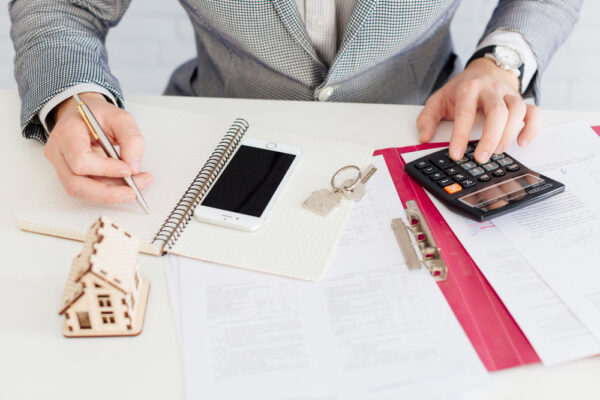
You need to submit a Self-Assessment tax return if you receive property income that exceeds certain limits. HMRC uses the tax return to calculate how much income tax you owe on your rental profits (income minus allowable expenses).
You must submit a Self-Assessment tax return if:
- Your total gross rental income (before expenses) is over £1,000 per year.
- You want to claim expenses over the £1,000 property allowance.
- You have joint ownership of a property (e.g. with a spouse), and the income is not split 50/50.
- You have foreign property income.
- You’re making a loss and want to carry it forward.
You don’t need to do a tax return just for property if:
- Your gross income is under £1,000, and
- You don’t want to claim any expenses or losses.
What Is the Property Allowance?
The property allowance is a tax-free allowance of £1,000 per year. If your property income is less than £1,000, you don’t need to tell HMRC. If it’s more than £1,000, you have two options:
Option 1: Use the £1,000 allowance
- No need to record expenses.
- Just deduct £1,000 from your gross rental income.
Option 2: Ignore the allowance and claim actual expenses instead
- Use this if your actual expenses are more than £1,000.
- You can’t use both – it’s either the allowance OR expenses.
Advantages:
- Simple – no receipts needed.
- Good for casual or very low-level landlords.
Disadvantages:
- Not tax-efficient if you have significant expenses.
- Can’t be used partially – it’s all or nothing.
What Needs to Be Declared on the Tax Return for Property Income?
When declaring property income on your tax return (SA105 form), you must include:
- Gross rental income (before expenses).
- Allowable expenses.
- Net rental profit/loss.
- Any capital allowances (rare for residential).
- Any property income losses from previous years (if carried forward).
- If it’s a joint property, your share of income and expenses.
- If it’s furnished holiday lets, report separately (special rules apply).
- If it’s overseas property income, use SA106 instead.
What are the common expenses which are allowable against Property Income?
- Mortgage interest (on buy-to-let) – now limited to 20% tax credit, not a full deduction.
- Letting agent fees
- Repairs and maintenance (e.g., fixing broken boiler)
- Insurance (e.g., landlord insurance)
- Council tax, water, gas, electricity (if paid by landlord)
- Service charges and ground rent
- Accountant or professional fees
- Advertising for tenants
- Legal fees (e.g. eviction, lease agreement – not purchase costs)
Less Common/Overlooked Expenses:
- Phone calls and stationery (if directly related to managing the property)
- Travel costs to and from the rental property (mileage claim or actual fuel)
- Direct cost of evictions or debt collection
- Subscriptions (e.g. landlord association fees)
- Costs of replacing domestic items (like sofas, white goods – not improvements)
Improvements (e.g. extension, new kitchen upgrade) are not allowable as revenue expenses, but may qualify for capital gains relief when you sell.
Do I Need to Keep Receipts for the Expenses?
Yes. You must keep records and receipts for all expenses you claim:
- Keep them for at least 5 years after the 31st January submission deadline.
- HMRC may ask to see proof if they open an enquiry.
Digital records (scans, photos) are acceptable.
How Will Reporting Change with Making Tax Digital (MTD)?
MTD for Income Tax (MTD ITSA) will replace the annual Self-Assessment for landlords from April 2026 (previously 2024, but delayed):
Who will be affected?
- Individuals with property and/or self-employment income over £50,000/year from April 2026.
- Threshold drops to £30,000/year from April 2027.
- Below £30,000 = no MTD requirement (yet).
Key changes:
- Quarterly updates:
- You’ll submit income and expenses every 3 months (digitally).
- No tax is paid quarterly – it’s just for info.
- Digital record-keeping:
- You’ll need to keep digital records (e.g. via software like QuickBooks, Xero, FreeAgent).
- End of Period Statement (EOPS):
- After the year-end, you’ll submit a final summary with any adjustments (like losses, capital allowances).
- Final declaration:
- Replaces the current Self-Assessment return.
What you’ll need:
- MTD-compatible software
- Digital record of income/expenses
- Possibly an accountant if you’re not confident managing digital compliance
Summary
| Topic | Summary |
|---|---|
| Need to do a return? | If property income > £1,000/year OR claiming expenses |
| Property allowance | £1,000 tax-free, but can’t claim expenses if you use it |
| What to declare | Gross income, expenses, profit/loss, tax reliefs |
| Allowable expenses | Mortgage interest, repairs, insurance, agent fees, etc. |
| Receipts | Keep for 5 years, digital copies are fine |
| MTD changes | Digital records + quarterly reporting from 2026 (over £50k income) |
